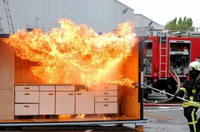Prairie Fare: Try These 5 Kitchen Fire Safety Questions
(Click an image below to view a high-resolution image that can be downloaded)
Our noses detected smoke as we unloaded our vehicle and the air was hazy. My husband and I were helping our daughter move into an apartment on the upper floor of an old building.
I checked my phone for the source of the fire. I learned that the smoke was blowing in from the wildfires in Canada.
Then a fire truck sped by with its siren blaring to an unrelated fire.
Fire was on our mind as we walked around the apartment. Like any parents, we want our children to be safe.
“There are two sprinklers in the bedroom and two in the living room,” my husband said as he did his impromptu inspection. I am surprised he wasn’t carrying a clipboard with a checklist.
We looked down the hallway to locate the stairs in case of an emergency.
I helped our daughter organize her kitchen cupboards. I added a few cookbooks.
“I think I will be doing a lot of cooking,” she said as she unloaded some pots, pans and other equipment received from some friends of mine. She was happy to have such nice equipment.
“You can invite us over for dinner soon,” I said.
“Let’s pick up a fire extinguisher for her,” my husband added.
Do you take precautions in your kitchen to avoid fires? According to a report compiled by Marty Ahrens and released in July 2020 by the National Fire Protection Association (NFPA), cooking was the top cause of home fires and home injuries from 2014 to 2018.
In fact, the percentage of kitchen fires in apartments was more than double the percentage of houses.
If you are reading this column, you probably do some cooking. Try these kitchen fire safety questions based on the information in the NFPA report.
Question 1. What appliance is linked to most cooking fires, including 87% of fire-related deaths?
- Slow cookers
- Ranges or cooktops
- Coffee pots
- Multifunction pressure cookers
Question 2. True or false. Gas ranges are linked to more fires than electric ranges.
Question 3. True or false. Unattended cooking was the leading cause of cooking fires from 2014 to 2018.
Question 4. What were most people doing during fatal injuries caused by fires?
- Sleeping
- Cleaning their home
- Working outdoors
- Watching TV
Question 5. Which two holidays are linked with the most home fires?
The answers are:
- B. Kitchen ranges or cooktops are linked to the most kitchen fires.
- False. Electric ranges are linked to more fires than gas ranges.
- True. Leaving the kitchen to do other things is linked with more fires than any other activity.
- A. Most people were asleep when a fire broke out. Stay awake and alert when cooking. Don’t leave food unattended, especially if it includes oil or is a higher-fat food. Grease feeds fires.
- Thanksgiving and Christmas are the peak days for home fires.
As you cook for yourself or teach family members safety tips, remember these key messages adapted from the NFPA:
- Stay alert. If you are sleepy or take medications that cause drowsiness, that’s not the time to begin frying bacon.
- Stay in the kitchen when you are frying, boiling, grilling or broiling. Turn off the burner if you leave the kitchen. Regularly check foods that you are simmering, baking or roasting.
- Keep things that can catch fire away from heat sources. Keep the surfaces clear of food. Keep oven mitts, wooden utensils, food packaging and towels away from the burners.
- Do not use your oven as an extra storage place. You might not check the oven before you preheat it.
- Wear short-sleeve clothing or clothing with tight sleeves, because long, loose sleeves could catch fire.
- Keep children and pets away from the cooking area. If you are teaching a child to cook, carefully supervise them around stovetops, ovens and other appliances. Do not hold an infant or young child as you are stirring or carrying hot food or liquids.
- Keep a lid nearby. If a small grease fire starts, smother the flame with the lid and turn off the burner. Do not move the pan. Do not pour water on the pan.
- If a fire breaks out in the oven, turn off the heat and keep the door closed.
- If you have a fire extinguisher, learn how to use it properly ahead of time. Learning how to use it during an emergency could put you and your home at risk.
Here’s an opportunity to use your oven and your end-of-the-season cherry tomatoes. This easy and tasty recipe was submitted by registered dietitian Deb Haugen for publication in our upcoming “Growing Together” cookbook. Our taste testers found it to be very delicious.
Cherry Tomato Crouton Casserole
8 cups cherry tomatoes with stems removed
½ bag seasoned croutons
½ cup Parmesan/Italian cheese blend
Rinse the tomatoes and pat dry. Grease two small glass pans or one large glass pan. Layer ingredients as follows: tomatoes, croutons, cheese, tomatoes, croutons, cheese. Bake about 45 minutes at 325 to 350 degrees Fahrenheit until cheese melts. You can begin the cooking process in a microwave oven if you wish to speed the process. Serve over rice or as a side dish.
Makes eight servings. Each serving has 90 calories, 3 grams (g) fat, 4 g protein, 11 g carbohydrate, 2 g fiber and 180 mg sodium.
(Julie Garden-Robinson, Ph.D., R.D., L.R.D., is a North Dakota State University Extension food and nutrition specialist and professor in the Department of Health, Nutrition and Exercise Sciences. Follow her on Twitter @jgardenrobinson)
NDSU Agriculture Communication – Oct. 7, 2021
Source: Julie Garden-Robinson, 701-231-7187, julie.garden-robinson@ndsu.edu
Editor: Kelli Anderson, 701-231-6136, kelli.c.anderson@ndsu.edu




